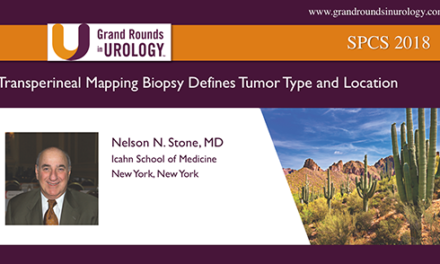Dr. Lucia presented at the 26th International Prostate Cancer Update on Thursday, January 21, 2016 on “Progress in Prostate Cancer Grading.”
Keywords: prostate cancer grading, Gleason score, cribriform, tumor
How to cite: Lucia, M. Scott. “Progress in Prostate Cancer Grading.” Grand Rounds in Urology. January 21, 2016. Jan 2025. https://dev.grandroundsinurology.com/prostate-cancer-m-scott-lucia-progress-in-prostate-cancer-grading/.
Progress in Prostate Cancer Grading – Edited Transcript
Using data and experience, it is possible to improve the existing prostate cancer grading system.
How can you have progress in prostate cancer grading? I maintain that for a grading system for any type of cancer, you should be able to refine and progress it using data and experience so that it performs better. This refinement is what has recently happened with prostate cancer grading.
In the mid-1960s, over 50 years ago, Don Gleason defined the Gleason Grading System. Since then, there has been a plethora of data to demonstrate how it works, how relevant it is, and also its limitations. Don Gleason was attempting to purvey two major components that indicate the aggressiveness of a tumor. One component is its degree of invasiveness, and the other is its morphological resemblance to a normal prostate. An example of this resemblance to a normal prostate is seen in Gleason’s painting of the microscopic appearance of cancer cells. This depiction shows low-grade cancer cells as well-described individual glands that are well-behaved. They are indicated by a rounded border, are impermeable, and are lined by cells that appear to be normal prostate epithelial cells.
At the other extreme, looking at pattern 5, the tumor cells have unevenly infiltrated the prostate as individual cells or sheets of cells and were unable to form glands. Also illustrated here are the appearances and corresponding degrees of invasiveness of the patterns in between pattern 1 and pattern 5. Gleason also described prostate cancer cells as being very heterogeneous, as there is often more than one grade pattern within an individual tumor, resulting in a rise of the Gleason score. He also described adding the most prevalent pattern to the second most prevalent pattern (as in 3 + 4).
Over the next 15 years, unbeknownst to many, Don Gleason made refinements to this system. This first one was in the 1970s, when he further defined the distinction between patterns 3 and 4. However, when published in 1992, after having added subdivisions (A, B and C patterns within the different grade tiers), the important detail of note is the area where the dotted line illustrates glands that straddle both sides of that tier.
Gleason himself had a certain degree of uncertainty as to where these types of morphologic patterns exist. One of the patterns, called the “cribriform” pattern, will be addressed here today.
The Gleason system has performed well. In the past 20 years, the area of concern of the system is with the high-grade patterns 4 and 5. The relative amount of those high-grade patterns within a tumor dictates how the tumor will behave. Looking at this chart, which includes almost 24,000 patients from studies at five major institutions, you see that the rate of survival in prostate cancer patients is represented in black. The Gleason 6 or below tumors behave very well, but as the relative proportion of patterns 4 and 5 increases, the outcomes are less and less favorable. This is shown here as 3 + 4, 4 + 3, and with 8 to 10 tumors, as well as the various age groups of patients who are below 60 years of age, in their 60s to 70s, and above 70 years of age. The Gleason System performs well, and the relative amount of pattern 4 and 5 cells is relevant.
There remains problems with the Gleason grading system that have been recognized for years. We now know, because we have tools available to us that Don Gleason didn’t have, such basal cell cytokeratins, that would show us that most of the patterns he described low-grade are likely only benign adenoses, or, at worst, components of higher grade tumors.
There was confusion about how to grade cribriform cancers. As I mentioned, there’s a line to straddle between pattern 3 and pattern 4. There are also certain variants of cancer that are not included in the Gleason System, such as ductal carcinoma or small-cell carcinoma. There are also problems with sampling; small-caliber needles used for biopsies sample only a portion of the tumor and may not reach the highest grade cancer cells present in the prostate.
In 2005, the International Society of Urologic Pathology (ISUP), of which I’m a member, met to address these issues, and to also provide guidelines for pathologists for grading using the Gleason System. Contrary to the belief that we completely changed everything about the grading system, we actually just refined the Gleason system based on data and experience.
Eighty leading genitourinary pathologists from all over the world got together to discuss their practices and the subsequent outcomes for comparison, for the benefit of the medical community, in terms of grading prostate cancer. The first thing we did was to place restrictions on the assignments of very low grades of cancer cells (patterns 1 and 2), recognizing that some were benign and also misleading because most tumors were upgraded to a higher Gleason number at the time of prostatectomy.
Long before we met in 2005, there was data from the CaPSURE system which showed that the relative amounts of Gleason patterns 2 through 4 fell dramatically over time because of the recognition of this issue.
We also looked at guidelines for assigning grade cribriform patterns. Though some of you may not have heard of the word “cribriform,” it’s a term pathologists should be concerned about. I’m going to show you some data to suggest why we should care. A cribriform pattern is a specific pattern that portends a worse diagnosis. Prior to that time we were divided in our thinking. We didn’t have sufficient data, so the practice was to keep those small areas of cribriform cancers rated “3.” If they were quite large, irregular, or unpleasant looking, we would rate them “4.” This practice was not precise and not very helpful to the community. We also discussed grading histological variants (for instance, ductal carcinoma was assigned a grade of 4), which I will not clarify at this time.
One of the more important results of the 2005 meeting was regarding how one is to grade biopsies. At that time our recommendation was that the most prevalent pattern, plus the highest remaining grade, be included in the Gleason score (whether or not the highest grade was the second-most prevalent), so that you essentially increase the grade of a biopsy.
There was data to support this long before our meeting. At the turn of the century, Johns Hopkins provided data that showed how the tumor behaves if you have very small amounts (less than 5%) of a high-grade pattern. If we disregard the Gleason score and the basic background of a tumor is equivalent to a Gleason 5 or 6, but there is a high-grade pattern present of less than 5%, the tumor behaved in a worse fashion; it behaved like a Gleason 7 tumor. If you had a Gleason 7 tumor with a very small amount of Gleason pattern 5, it behaved worse, as if we should have included the “5” in the score in the first place. There is data to support this.
On the other side of the country, Stamey’s group at Stanford concluded the same thing at about the same time. Looking at prostatectomy data, they said that the relative proportion of the tumor that is pattern 4 or 5 governs biochemical failure rates. Also, the higher the proportion of patterns 4 and 5, the more likely you are to fail, even at very low amounts.
How did the changes that we looked at in 2005 affect things? Here is data from Johns Hopkins again, looking at grading tumors using the 2005 modified Gleason criteria that we already talked about, and which showed very good performance. If you look here, the Gleason 6 tumors are below the top tier. In terms of biochemical recurrence, either by grading through biopsy or prostatectomy specimens, these have a very low chance of biochemical recurrence over 7 years. And recurrence goes up as the relative proportion of patterns 4 and 5 increase. So here’s 3 + 4, 4 + 3, 8, and 9 to 10s over here. Remember these five tiers, because we’re going to refer to them again later.
Here’s a multivariate regression analysis that shows that the biopsy Gleason score with the modified criteria works very well for stratifying tumors. You can see the hazard ratios go up almost exponentially as you increase the tier.
There were some issues left unsettled, and so the ISUP met again in late October 2014 to discuss a few more things. In that meeting there were 85 GU pathologists, and we also invited 17 clinicians from across the world. There was clarification on these morphologic patterns, what we do with them, and how they behave. In particular, when grading cribriform and glomeruloid patterns, the impetus here was that we now have data to suggest that these behave more aggressively than a Gleason pattern 3.
Here’s what we mean by a cribriform pattern: it is a pattern in which you have sheets of tumor cells, in which there are punched-out holes. Individually, they don’t produce effective glands, but make these punched-out holes. Here, it isn’t clear, but this is a large lesion (because this is a lower power than here), and this would have been graded as 4 by ISUP 2005. And these smaller things, as well as these glomerular patterns (they almost look like glomeruli of a kidney), would have been called pattern 3.
But at that time there wasn’t data to justify that method of grading tumors. Since then, we’ve compiled the needed data. This is data from our institution where we looked at individual patterns. This is pretty difficult to see, so I’ll outline what I’d like to show here. Here we looked at individual grade patterns, and the area in green is the cribriform pattern. And we also considered size—large or small—but found no difference. These things behaved badly. Here is the odds ratio: anywhere from 5.5 to 6 in terms of PSA progression over five years. So, they performed aggressively. They even outperformed Gleason pattern 5 in terms of severity, and they seem to be a phenomenon that we need to be thinking about.
Here is a study out of the Netherlands that also looked at this—It is probably a more elegant study than ours. They looked specifically at Gleason score 7 prostate cancer, and they looked at it as a conventional Gleason score 7, or those with any amount of cribriform growth in it. Any amount was shown to have an impact on biochemical recurrence, metastasis-free survival, and disease-specific survival. You can see that our hazard ratio is here with any amount of cribriform tumor that is present. The cribriform pattern is important to mention. I think that as pathologists we need to start doing this; we need to start saying that if you have a Gleason 7 tumor with a component of cribriform, that is information you need.
The other thing from the 2014 meeting that was impactful was an adoption of a new grade classification based upon the Gleason patterns.
Essentially the question is this: in the modern contemporary era, does it still make sense to continue to use a 2 to 10 scale grading system? We know that Gleason score 6 has favorable outcomes; I showed you the data. Yet, to the patient, a Gleason score of 6 falls halfway between Gleason score 2 and 10: how can you say it’s a low grade? It’s right in the middle. To patients, it’s an intermediate grade. I think that contributes to their reluctance to choose active surveillance. Gleason scores of 2 to 5 are rarely used these days and are not prognostically different than a Gleason score 6. And what I’ve told you over and over again is that Gleason patterns 4 and 5 are the most important scores for prognosis. What we need is a better way to relay this information to the patient so that he can make more informed decisions. So the discussion revolved around making prognostic grade groups. And remember those tiers that I looked at? Gleason 6 or below would be defined as Prognostic Grade Group I; 3 + 4 as II; 4 + 3 as III; 8 as IV; and 9 to 10 as V. In other words, as you progressively increase the relative amount of Gleason patterns 4 and 5, it affects the assignment of prognostic groups.
This method was received favorably, and was voted into adoption with a 90% consensus. It is recommended that we further define the percentage of pattern 4 within these categories. And also, all modifications to the Gleason system should be used. So it isn’t a new grading system per se, but it’s using the existing system in a smarter way.
Since then, there have been some validation studies. This one is a multi-institutional study out of Australia (including institutions in both Australia and Canada), that looks at the different grade groupings (ISUP grade 1 and grade 5). As you go up from grade 1 to grade 5, you see a progressive increase in lymph node metastases, seminal vesicle invasion, and extraprostatic invasion. You can also see that the hazard ratios for biochemical recurrence increased almost exponentially across those tiers.
This is another multi-institutional study, the RADAR trial, looking at the issue with outcomes over a span of 7 years. In it, with the ISUP grade of 1, and if the pattern was categorized correctly, there were no deaths and no metastases over those seven years. And you can again see an almost exponential increase in the hazard ratio as you move through the grade groupings.
With the grade groupings, the 2014 ISUP recommendations versus the 2005 recommendations were considered, and showed higher concordance indexes with predicted outcomes for all of these groupings. As these outcomes were significant, the modifications seem to be authentic.
On a genetic level, this has also been shown. This is Mark Rubin’s data looking at the two groups. With ISUP group 1, and then 5 over here, including all the information in between, you can see that the relative proportion of copy number abnormalities across those tiers increases as you go from left to right, truly validating that we are seeing something that is real and performs well.
I’m going to conclude by saying that grade is still the strongest indicator of prognosis we have. We have to use grade in an intelligent way. In order to do this, we should identify those patients who are candidates for active surveillance: mainly, prognostic group 1. The Gleason grading system itself has undergone many refinements. And now that the 5-tier prognostic grade groupings proposed by the 2014 ISUP meeting are based on the Gleason system, and they’re easily understandable, validation studies have now confirmed clinical utility.
ABOUT THE AUTHOR
M. Scott Lucia, MD, is Professor and Vice Chair of the Department of Pathology and Director of Anatomic Pathology and of the Prostate Diagnostic Laboratory at the University of Colorado Anschutz Medical Campus (UCAMC) School of Medicine. He also serves as the Director of the Prostate Cancer Research Laboratories at UCAMC and of the UCAMC Biorepository Core Facility. Dr. Lucia received his MD from the University of Colorado School of Medicine in 1988. He completed his internship and residency in pathology at the University of Colorado in 1993. He was a research fellow in the Laboratory of Chemoprevention at the National Institutes of Health from 1993 to 1995, before returning to the University of Colorado in 1995.
Dr. Lucia served as the primary pathologist for the Prostate Cancer Prevention Trial (PCPT) and Vitamin E and Selenium Chemoprevention Trial (SELECT), sponsored by the Southwest Oncology Group; the Medical Therapy of Prostate Symptoms (MTOPS) trial, sponsored by the NIDDK; and the Reduction with Dutasteride of Clinical Progression Events in Expectant Management of Prostate Cancer (REDEEM), sponsored by GlaxoSmithKline. He directs the operation of several tissue and serum biorepositories for prostate and prostatic diseases, including those for the PCPT, MTOPS, SELECT, and the University of Colorado Cancer Center Prostate Biorepository. He has authored or co-authored over 180 peer-reviewed articles, reviews, editorials, and book chapters. His primary areas of interest include pathology of prostate cancer and hyperplasia, early detection and prevention of prostate cancer, prostate cancer biomarkers, and mechanisms of carcinogenesis.





